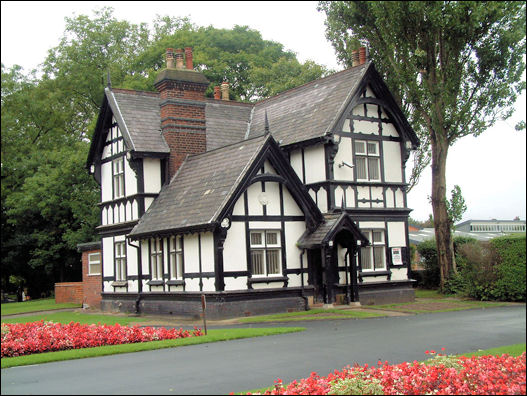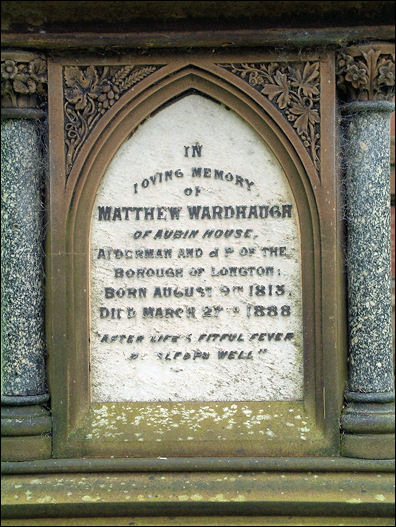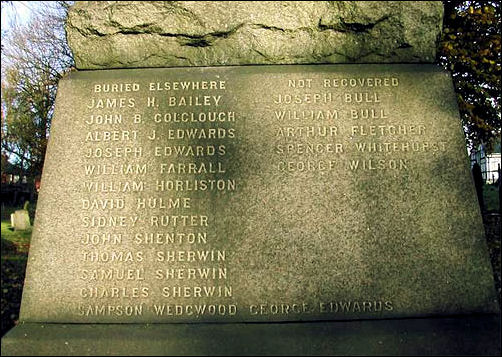|
the history of Longton Cemetery
  
click the
"contents" button to get back to the main index & map
next: Hanley Cemetery
previous:
Burslem Cemetery
|
Historian Fred Hughes
writes....
Diane McDaid’s neighbours won’t be calling round for a festive drink this
Christmas; she says they’ve already got enough spirits. The owner of a
popular Stoke on Trent restaurant Diane has plenty of friends who are very
welcome to call for a drop of cheer; it’s just the neighbour’s who won’t
be getting an invite. And the reason for this parsimonious inhospitality
is simply that Diane’s neighbours are all dead.
“Earlier this year I bought Longton Cemetery Lodge from the council,”
she tells me. “I fell in love with the mock-Tudor detached building as
soon as I saw it. I suppose living in a cemetery would put most people
off but my passion is restoring and changing the use of public
buildings. For instance my conversion of the old chapel in Town Road
Hanley into a restaurant gave new life to a building facing demolition.
In renovating Longton Cemetery Lodge I’m merely bringing the past into
the present. It’s exciting.”

Longton Cemetery -
Registrar's office
Diane’s new home was built in 1877, the year Longton cemetery opened.
“Its first occupant was a chap name Joseph Ashworth who was appointed
registrar and accountant by Longton Borough Council,” says historian Steve
Birks. “Joseph, a bachelor age 47 and his housekeeper sister Mary, age 49
and also single, came from Yorkshire, but little is known of their
previous lives.”
According to the council minutes Ashworth had an annual salary of £100
with the house added rent free. Gas and other services were also included
but exclusively for the office. Victorian prudence no doubt influenced the
Ashworth’s to spend most of their time in the office, a pleasant
sun-filled room by the front entrance.
“I love the office,” says Diane. “Even the original wardrobe safe is still
here. Nothing has been altered from those times and even now I expect to
be greeted by a wing-collared registrar wearing a morning coat and a black
top hat. It’s as though I’m living inside Victorian history.”
What about the neighbours, I ask.
“Oh I don’t anticipate trouble from them,” she laughs.
|
Longton cemetery off Spring Garden Road is typical Victorian parkland
laid-out in a rectangle of about 21 acres extended four times to
accommodate the increase in burials.
“The ground was originally owned by Mr J Edwards-Heathcote, a member of
the family that, along with the Duke of Sutherland, seemed to own most
of Longton. But he didn’t give his land away. Instead he charged Longton
Council £500 an acre thereby pocketing a cool ten grand. All this took
place when local boroughs were being compelled to provide new burial
space for its dead. Until 1650 most parishioners were buried in vaults
inside the church or in land surrounding them known as churchyards. But
when the churchyards became overfull, private cemeteries became a
popular option. Except for the poor whose population in the new town
centres was burgeoning rapidly,” says Steve.
The first public burials were tested in Norwich in 1819. But it was slow
to take hold as people feared detachment from church proximity. However,
by the middle of the 19th century urban churchyards were so
crowded and polluted that legislation was introduced to compel local
authorities to provide land for public burials. London’s Metropolitan
Interment Act of 1850 was the first, soon to be extended across the
country in 1853. |
“In 1860 Hanley became the Potteries’ first authority to comply with this
legislation,” says Steve, “Longton followed seventeen years later. This
was probably because of the unavailability of public land and the tricky
negotiations with other landowners before accepting Edwards-Heathcote’s
transaction of convenience. Anyway the land was divided up into partitions
of religious belief. Five acres was allotted as the Church of England
burial-ground. Beside this was the Nonconformists’ plot. And some other
part was set aside for the Roman Catholics. The superb listed central
chapel is a joy to look at and was designed locally and built by a Walsall
company with timber frames and Welsh slate roofs.”

Longton Cemetery -
Chapels
There are actually two chapels beneath one roof; Nonconformist and
Anglican. Each has three bays either side of an arched entrance beneath an
impressive tower designed with two stages of ornate timber panels and a
small spire. The main entrance has segmental archway gables with stained
glass quatrefoil windows and decorative timber panelling.

Grave memorial of
Matthew Wardhaugh
“The surrounding land is relatively flat,” Steve adds. “But possibly
because of its late construction many of Longton’s Victorian notables are
buried elsewhere. Nevertheless the grave of Matthew Wardhaugh is here. He
was a Victorian theatre proprietor who built the Royal Victoria Theatre in
Berry Bank, Stafford Street, now called The Strand. He wrote and performed
at least 50 plays. Most popular was his last play, My Little Wife
alternatively known as Nuts to Crack. Yes, it’s true!”

the names of those buried
in other burial grounds
and those not recovered
Another fine memorial is the granite tribute to the 64 miners killed in
the Mossfield Colliery explosion in 1889. The remains of 45 miners are
buried here together. Another 14 are buried elsewhere. But perhaps the
saddest are the five names listed beneath the simple stone-carved
valediction ‘not recovered’.
 more on Longton
Cemetery
more on Longton
Cemetery
|
![]()
![]()
![]()